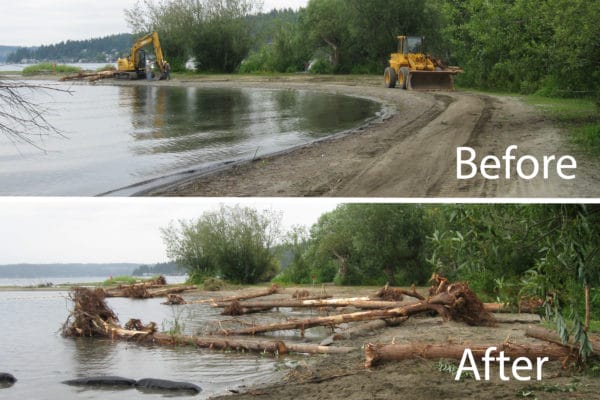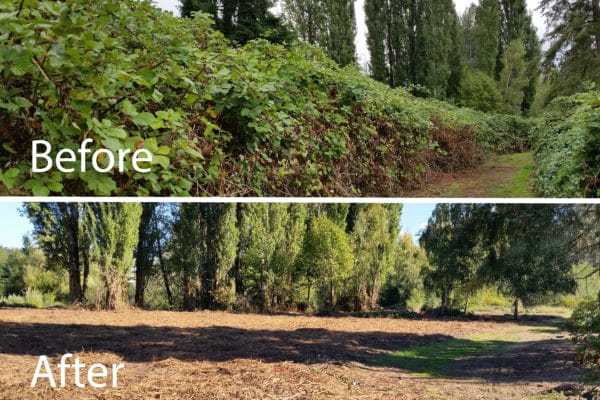Twenty Years Transforming Issaquah Creek
A major transformation has taken place along Issaquah Creek, fueled by the passionate work of residents, volunteers, and leaders. Piece by piece, these open spaces are becoming healthier, stronger, and more resilient, even as the urban areas surrounding them continue to boom.
The restoration of Issaquah Creek is a story about what can happen when a community comes together to balance ecological health with economic drive—it’s a model for restoration that shows the power of local investment to make change.
In 1998, stakeholders developed a shared strategy that was locally-led and highly-collaborative, resulting in the Lake Washington-Sammamish-Cedar River Watershed Council. For over 20 years, residents, officials, activists, and partners have come together to make sure that watershed improvements for fish also lead to improvements for the broader ecosystem and surrounding community.
 It takes just a quick stroll along one of the city’s many parks to see the benefits of these decades of restoration. On any given day, you may spot a great blue heron or bald eagle, two of more than 100 species of birds that call the Lake Sammamish ecosystem home. And while a full 1/8 of North American bird species migrate through or nest near Issaquah Creek, winged creatures aren’t the only ones who find refuge here: black bear, mountain lions, and bobcats regularly pass through. And, if you come during one of the salmon runs you’ll see Chinook, coho, and sockeye returning to spawn.
It takes just a quick stroll along one of the city’s many parks to see the benefits of these decades of restoration. On any given day, you may spot a great blue heron or bald eagle, two of more than 100 species of birds that call the Lake Sammamish ecosystem home. And while a full 1/8 of North American bird species migrate through or nest near Issaquah Creek, winged creatures aren’t the only ones who find refuge here: black bear, mountain lions, and bobcats regularly pass through. And, if you come during one of the salmon runs you’ll see Chinook, coho, and sockeye returning to spawn.
Adjacent to these open space is a booming city, with the corporate headquarters for Costco Wholesale and a vibrant downtown filled with restaurants, a local theatre, and shopping, all supporting a population of 37,000, located just a few miles from Seattle. Just like in other areas of the Greenway, growth doesn’t have to preclude nature, and vice versa.
Today, numerous parks and public open spaces line Issaquah Creek. But it wasn’t always this way.
 During the 1800s and 1900s, most of the creek was privately owned and experienced a significant loss of forest habitat. The ‘Pickering’ stretch of the creek offers a window into some of the historical common uses: Washington’s fifth territorial governor, William Pickering, owned this creekside property, which was cleared of trees and used as a dairy farm throughout the 1860s. Development continued through WWII and beyond, with the addition of a local airfield. Along the rest of the creek similar changes were taking place, as forest gave way to development as the creek weaved through a growing town.
During the 1800s and 1900s, most of the creek was privately owned and experienced a significant loss of forest habitat. The ‘Pickering’ stretch of the creek offers a window into some of the historical common uses: Washington’s fifth territorial governor, William Pickering, owned this creekside property, which was cleared of trees and used as a dairy farm throughout the 1860s. Development continued through WWII and beyond, with the addition of a local airfield. Along the rest of the creek similar changes were taking place, as forest gave way to development as the creek weaved through a growing town.
By the 1990s, the community began realizing that these developments were leading to unintended consequences, including seasonal flooding of the downtown area, a rapidly declining salmon population, and wildlife and residents alike struggling to access the creek. Something had to be done.
The City of Issaquah, Washington State Parks, King County, Greenway Trust, and others banded together to plan for the recovery of Issaquah Creek. First, they identified parcels that were best stewarded in public ownership, leading to the public acquisition of many acres of wetlands and riparian habitat. The next step was to restore these lands and the private lands around them. Greenway volunteers have been an integral part of restoration, contributing over 60,000 hours removing invasive weeds and planting nearly 52,000 native trees.
 The restoration process takes many steps and many years to complete. We start by bringing back the native trees and shrubs that make up a healthy, productive creek bank ecosystem. But often invasive weeds present a big obstacle to jump-starting natural regeneration. Blackberry, ivy, and other invasive weeds must be pulled out, dug out, sprayed, or otherwise controlled before the newly planted trees develop a shady canopy that supports natural conifer recruitment.
The restoration process takes many steps and many years to complete. We start by bringing back the native trees and shrubs that make up a healthy, productive creek bank ecosystem. But often invasive weeds present a big obstacle to jump-starting natural regeneration. Blackberry, ivy, and other invasive weeds must be pulled out, dug out, sprayed, or otherwise controlled before the newly planted trees develop a shady canopy that supports natural conifer recruitment.
Yet, invasive species removal and tree planting along the creek are just two of the tools used to improve habitat: it’s also important to improve the health within the creek itself. Large woody debris (LWD)—normally present in a healthy creek—is almost entirely absent from the lower reaches of Issaquah Creek. LWD creates pools and other in-water features and provides spawning, rearing, resting, food production, and refuge habitat for salmon. A new project is underway to reinstall more LWD. When the project is finished, more than $1 million of logs and stumps will have been installed to provide safer passage for fish and increase the hydrologic complexity of the stream. Someday, conifers and large trees will regenerate on their own and supply LWD directly into the creek as the trees mature.
Restoration is a long-term investment that is rarely linear. It’s about leaving a legacy that will outlive all of us who work to restore the Greenway, and the work truly takes many hands to accomplish.
After 20 years of hard work the benefits of restoration are easy to see. Just one of many examples is the area behind the Alpine Animal Hospital on Lake Sammamish Road—if you visit there you’ll see an older restoration site with an established canopy of native trees where blackberry bushes once thrived–now ready for understory planting. Through it all, agencies, taxpayers, and volunteers have committed to long-term funding and maintenance for restoration projects.
We’ll keep working to restore more sections of Issaquah Creek. You can pitch in now by volunteering at the Greenway Native Plant Nursery-–and look out later this year for restoration events along Issaquah Creek!





